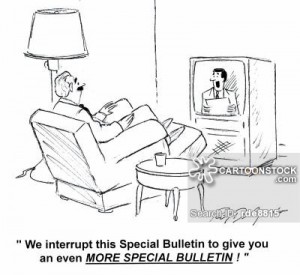Sensationalism has manifested in multiple forms of journalism over time. In the 1830s, there were the penny papers. In the 1880s and 1890s, it shown through in the yellow journals. In the 1920s, tabloids became dominant in sensationalist use.
Each of these forms of journalism utilized sensationalistic tactics to cater to and draw their audiences in. Specifically, these forms of journalism utilized sensationalism because they were the most popular news source at the time and they wanted to stay that way.
This trend, of sensationalist use coinciding with the dominant news monger of the day, has translated more recently into television.
This trend, while it took awhile to actually come about in television, is shown greatly in the way news stories are broadcast on television. Flashy titles, special music that people have learned to connect with breaking news, titles such as “special news report,” and constant playback of a story provide the perfect ingredients for media hype, drawing in viewers.
Further, sensationalism shines on television in the form of tabloid talk shows, and reality television.
These genres of television rely on the sensationalism of their cast members and guests to maintain popularity. Without sensationalist tactics, television, both in the form of news and entertainment, would not be nearly as popular as it is today. It is thanks to the utilization of sensationalism that television had become and remained important and central to the gathering of news today.


Leave a response